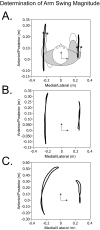Arm swing magnitude and asymmetry during gait in the early stages of Parkinson's disease
- PMID: 19945285
- PMCID: PMC2818433
- DOI: 10.1016/j.gaitpost.2009.10.013
Arm swing magnitude and asymmetry during gait in the early stages of Parkinson's disease
Abstract
The later stages of Parkinson's disease (PD) are characterized by altered gait patterns. Although decreased arm swing during gait is the most frequently reported motor dysfunction in individuals with PD, quantitative descriptions of gait in early PD have largely ignored upper extremity movements. This study was designed to perform a quantitative analysis of arm swing magnitude and asymmetry that might be useful in the assessment of early PD. Twelve individuals with early PD (in "off" state) and eight controls underwent gait analysis using an optically-based motion capture system. Participants were instructed to walk at normal and fast velocities, and then on heels (to minimize push-off). Arm swing was measured as the excursion of the wrist with respect to the pelvis. Arm swing magnitude for each arm, and inter-arm asymmetry, were compared between groups. Both groups had comparable gait velocities (p = 0.61), and there was no significant difference between the groups in the magnitude of arm swing in all walking conditions for the arm that swung more (p = 0.907) or less (p = 0.080). Strikingly, the PD group showed significantly greater arm swing asymmetry (asymmetry angle: 13.9 + or - 7.9%) compared to the control group (asymmetry angle: 5.1 + or - 4.0%; p = 0.003). Unlike arm swing magnitude, arm swing asymmetry unequivocally differs between people with early PD and controls. Such quantitative evaluation of arm swing, especially its asymmetry, may have utility for early and differential diagnosis, and for tracking disease progression in patients with later PD.
Copyright 2009 Elsevier B.V. All rights reserved.
Figures


References
-
- Gelb DJ, Oliver E, Gilman S. Diagnostic criteria for parkinson disease. Arch Neurol. 1999;56(1):33–39. - PubMed
-
- Alice N, Fabienne C, Anne-Marie W, Kaat D. Does freezing in parkinson's disease change limb coordination? A kinematic analysis. J Neurol. 2007;254(9):1268–1277. - PubMed
-
- Ferrarin M, Rizzone M, Bergamasco B, Lanotte M, Recalcati M, Pedotti A, Lopiano L. Effects of bilateral subthalamic stimulation on gait kinematics and kinetics in parkinson's disease. Exp Brain Res. 2005;160(4):517–527. - PubMed
-
- Knutsson E. An analysis of parkinsonian gait. Brain. 1972;95(3):475–486. - PubMed
-
- Nieuwboer A, De Weerdt W, Dom R, Lesaffre E. A frequency and correlation analysis of motor deficits in parkinson patients. Disabil Rehabil. 1998;20(4):142–150. - PubMed
Publication types
MeSH terms
Grants and funding
LinkOut - more resources
Full Text Sources
Other Literature Sources
Medical

